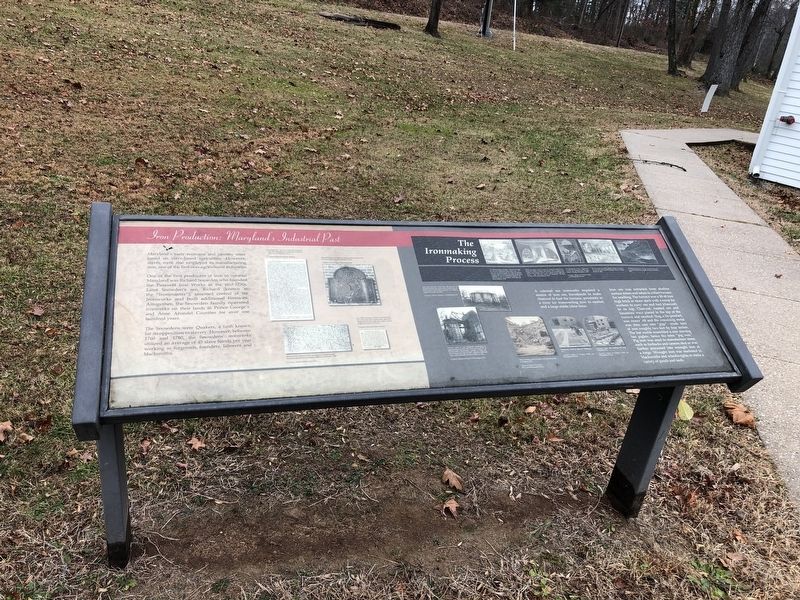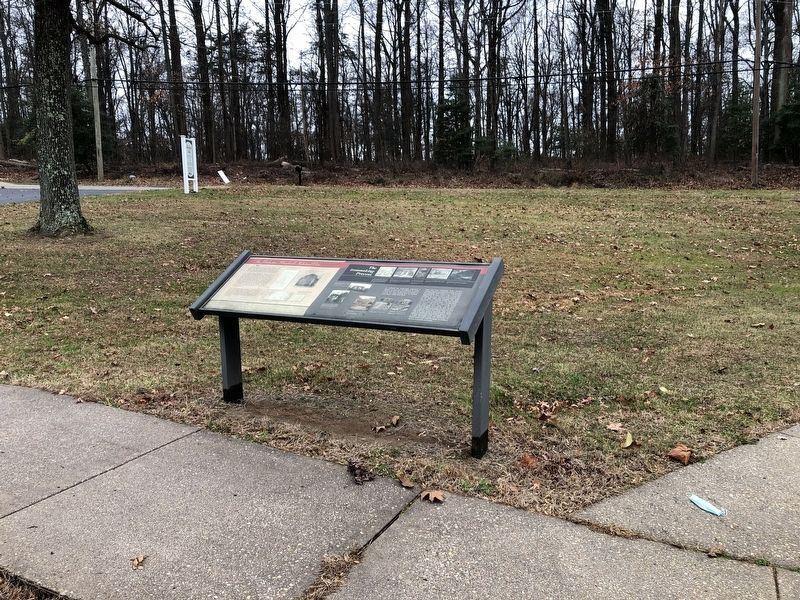Near Beltsville in Prince George's County, Maryland — The American Northeast (Mid-Atlantic)
Iron Production: Maryland's Industrial Past / The Ironmaking Process

Photographed By Devry Becker Jones (CC0), December 11, 2021
1. Iron Production: Maryland's Industrial Past / The Ironmaking Process Marker
Iron Production: Maryland's Industrial Past
Maryland's early economy and identity were based on slave-based agriculture. However, slaves were also employed in manufacturing iron, one of the first non-agricultural industries.
One of the first producers of iron in colonial Maryland was Richard Snowden who founded the Patuxent Iron Works in the mid-1730s. Later Snowden's son, Richard (known as the "Ironmaster"), assumed control of the Ironworks and built additional furnaces. Altogether, the Snowden family operated ironworks on their lands in Prince George's and Anne Arundel Counties for over one hundred years.
The Snowdens were Quakers, a faith known for its opposition to slavery. However, between 1760 and 1780, the Snowdens' ironworks utilized an average of 45 slave hands per year working as forgemen, founders, laborers and blacksmiths.
The Ironmaking Process
A colonial era ironworks required a source of iron ore, forestlands to make charcoal to fuel the furnace, proximity to a river for transporting iron to market, and a large stable labor force.
Iron ore was extracted from shallow surface mines and taken to a blast furnace for smelting. The furnace was a 30-40 foot high brick or stone stack with a ramp for workers to carry ore and fuel (charcoal) to its top. Charcoal, roasted ore and limestone were placed in the top of the furnace and smelted. Slag, a by-product, was drawn off and the remaining metal was then cast into "pigs" — crude bars of iron roughly two feet by four inches. The bar molds resembled a sow nursing her piglets, hence the term "pig iron." Pig iron was used to manufacture items such as firebacks and cannon shot or was further processed into wrought iron at a forge. Wrought iron was marketed to blacksmiths and wheelwrights to make a variety of goods and tools.
[Captions:]
A workman (figure 4) lights a furnace through the top and combustion gets under way. AS more air is needed (figure 5), vents are opened. The fire must be tended constantly (figure 6) to regulate the rate of combustion (figure 7, 8) until the process is complete. Charcoal II, by Denis Diderot, 1751.
Workers prepare a bed of sand as a mold for motletn iron. Once the mold is formed, the hearth will be tapped and molten iron will flow into it. The workers on the right cart away a "pig" that has cooled and hardened. The Blast Furnace V, by Denis Diderot, 1751.
After the Civil War, brick kilns like this one at Muirkirk Ironworks were used to make charcoal from wood. Prior to this, charcoal was made in earthen mounds, ca. 1922.
Furnace used at the Muirkirk Ironworks to manufacture pig iron.

Photographed By Devry Becker Jones (CC0), December 11, 2021
2. Iron Production: Maryland's Industrial Past / The Ironmaking Process Marker
Erected by Maryland-National Capital Parks and Planning Commission.
Topics and series. This historical marker is listed in these topic lists: African Americans • Colonial Era • Industry & Commerce. In addition, it is included in the Quakerism series list. A significant historical year for this entry is 1760.
Location. 39° 3.547′ N, 76° 52.399′ W. Marker is near Beltsville, Maryland, in Prince George's County. Marker is on Old Muirkirk Road, 0.2 miles north of Muirkirk Road, on the right when traveling north. Touch for map. Marker is at or near this postal address: 7612 Old Muirkirk Rd, Beltsville MD 20705, United States of America. Touch for directions.
Other nearby markers. At least 8 other markers are within walking distance of this marker. When the Iron was Hot: African American Ironworkers of Muirkirk (here, next to this marker); Abraham Hall: An African American Benevolent Lodge (a few steps from this marker); Three Sisters: Close Knit Communities of the Laurel Area (a few steps from this marker); Queen’s Chapel Methodist Church, Established 1868 (approx. 0.2 miles away); The Dinosaurs of Dinosaur Park (approx. 0.8 miles away); Welcome to Dinosaur Park (approx. 0.8 miles away); The Industrial Heritage of Dinosaur Park (approx. 0.8 miles away); Meet Astrodon johnstoni (approx. 0.8 miles away). Touch for a list and map of all markers in Beltsville.
Related marker. Click here for another marker that is related to this marker. This marker has replaced the linked marker.
Credits. This page was last revised on December 11, 2021. It was originally submitted on December 11, 2021, by Devry Becker Jones of Washington, District of Columbia. This page has been viewed 398 times since then and 45 times this year. Photos: 1, 2. submitted on December 11, 2021, by Devry Becker Jones of Washington, District of Columbia.